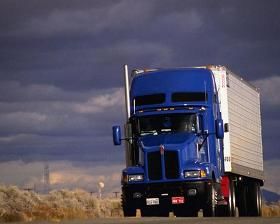Offset Backing And Alley
Topic 7972 | Page 1
Started offset yesterday morning, thought I did OK; today not once was I able to get.
I think backing is the hardest part of learning to drive a semi. But that's the part that's most important. One of my instructors said anyone can drive a semi down the interstate. But you need to know shifting and backing to make it worthwhile.
That 90° alley dock almost "killed" me. I finished Swift Academy in January, began solo late February. Today I accomplished a true 90 at two different terminals.
My point is, yes, you need to learn this baby, especially so you can test out of school! But later as you get your experience, you'll be able to see the line to follow.
I still don't like to back dock, but ya gotta do whatcha gotta do.
Patience, Mindes. Remember the tandems will mostly move ten feet before you see the affect of the turn you started.
Terminal:
A facility where trucking companies operate out of, or their "home base" if you will. A lot of major companies have multiple terminals around the country which usually consist of the main office building, a drop lot for trailers, and sometimes a repair shop and wash facilities.
Tandems:
Tandem Axles
A set of axles spaced close together, legally defined as more than 40 and less than 96 inches apart by the USDOT. Drivers tend to refer to the tandem axles on their trailer as just "tandems". You might hear a driver say, "I'm 400 pounds overweight on my tandems", referring to his trailer tandems, not his tractor tandems. Tractor tandems are generally just referred to as "drives" which is short for "drive axles".
Tandem:
Tandem Axles
A set of axles spaced close together, legally defined as more than 40 and less than 96 inches apart by the USDOT. Drivers tend to refer to the tandem axles on their trailer as just "tandems". You might hear a driver say, "I'm 400 pounds overweight on my tandems", referring to his trailer tandems, not his tractor tandems. Tractor tandems are generally just referred to as "drives" which is short for "drive axles".
Interstate:
Commercial trade, business, movement of goods or money, or transportation from one state to another, regulated by the Federal Department Of Transportation (DOT).

We start testing next week so there's plenty of time left for it to click and that light bulb goes off.

Remember to turn the wheel towards your problem when you back. Too close on the driver's side? Turn the wheel left. Too close to the cone on the passenger side? Turn the wheel right. Can't turn anymore? Use a pull up. A pull up is a point, hitting the cone is two. the line the cone was on is two more. Eat the pull up point before you hit a cone. The biggest mistake I've seen folks make doing a 90* Alley is cutting the wheel while they are moving and using up all their maneuvering room. Stop, turn, then go. There are a couple of ways to get it in there, some folk straight back to within six feet, then jackknife one way then jack it back the other and they're in. Others start into the 45* from the get-go and keep it banana-shaped the whole way until that final cut to straighten it out. Both work, but what I said before goes for either method. Turn to your problem, but not while you're moving.

On my testing I had a left offset. I got the tail of the trailer in between cones, the pulled straight out from the opening as far forward as I could go. Then just straight backed it in. Similar with alley, get those wheels as close to the left cone and then pull up and straight back it. Use all available space and use your goals.
HOS:
Hours Of Service
HOS refers to the logbook hours of service regulations.New Reply:
New! Check out our help videos for a better understanding of our forum features

















Preview:








 TT On Facebook
TT On Facebook
Started offset yesterday morning, thought I did OK; today not once was I able to get.
Started alley docking today, for the life of me cannot get that going right either. This afternoon should be going out on the road again.